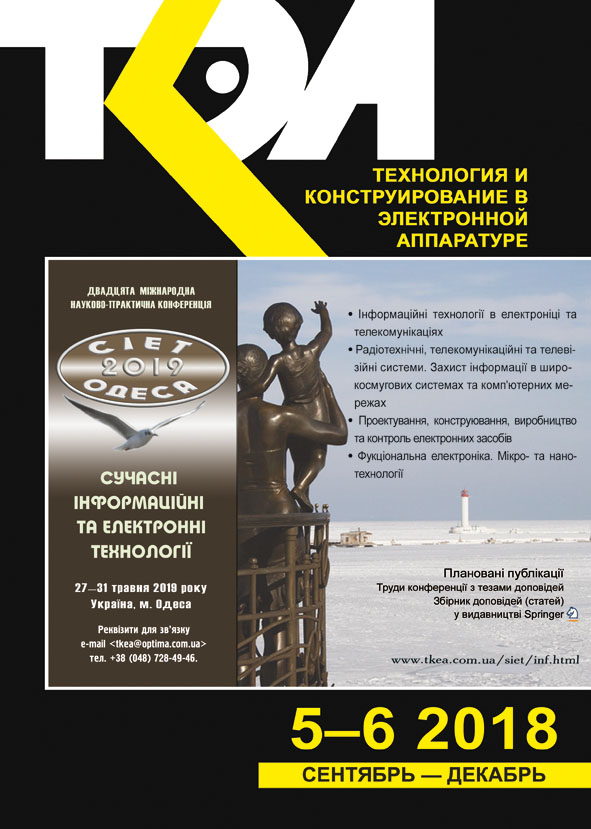Дослідження ширини забороненої зони в змішаних кристалах ZnSxSe1–x
Анотація
Сцинтилятори на основі ZnSxSe1–x є перспективними матеріалами для рентгенівських і гамма-детекторів. Для оптоелектронних пристроїв краще використовувати напівпровідникові сполуки з прямозонною енергетичною структурою, спектральний діапазон яких лежить в області фундаментального поглинання. Ширина забороненої зони в таких напівпровідниках є важливим параметром, який впливає на енергетичну роздільну здатність, енергію іонізації, темновий струм і інші сцинтиляційні характеристики.
У даній роботі досліджено вплив вмісту сірки на оптичну ширину забороненої зони в змішаних кристалах ZnSxSe1–x.
Зразки для досліджень були вирощені методом Бріджмена — Стокбаргера в графітових тиглях діаметром 25 мм в атмосфері аргону (PAr = 2·106 Па) за температури від 1870 до 2000 К залежно від складу вихідної шихти. Отримано шість зразків з різним вмістом компонентів, а саме: ZnS0,07Se0,93; ZnS0,15Se0,85; ZnS0,22Se0,78; ZnS0,28Se0,72; ZnS0,32Se0,68; ZnS0,39Se0,61.Прозорість зразків становила від 61 до 67% на довжині хвилі 1100 нм (товщина зразків 4 мм), що вказує на високу оптичну якість кристалів. Встановлено, що для змішаних кристалів ZnSxSe1–x зі зростанням вмісту сірки х від 0,07 до 0,39 оптична ширина забороненої зони зростає від 2,59 до 2,78 еВ для прямих переходів і від 2,49 до 2,70 еВ для непрямих. Проведено порівняння між теоретичними й експериментально отриманими значеннями ширини забороненої зони. Показано, що ширина забороненої зони досліджуваних зразків плавно залежить від складу, при цьому формування нових (дефектних) рівнів в забороненій зоні не відбувається, що вказує на можливість вирощування ZnSxSe1–x змішаних кристалів методами спрямованої кристалізації для використання як рентгенівських і гамма-детекторів. Більш широка заборонена зона і більш високе атомне співвідношення напівпровідника ZnSxSe1–x в порівнянні з кристалами ZnSe(Te, Al) розширюють область його застосування.
Посилання
Emam-Ismail M., El-Hagary M., Ramadan E. et al. Influence of g-irradiation on optical parameters of electron beam evaporated ZnSe1–xTex nanocrystalline thin films. Radiation Effects and Defects in Solids, 2014, vol. 169, iss. 1, pp. 61–72, https://doi.org/10.1080/10420150.2013.811505
Shcotanus P., Dorenbos P., Ryzhikov V. Detection of CdS(Te) and ZnSe(Te) scintillation light with silicon photodiodes. IEEE Transactions on Nuclear Science, 1992, vol. 39, iss. 4, pp. 546–550, https://doi.org/10.1109/23.159663
Hajj Hussein R., Pagès O., Firszt F. et al. Near-forward Raman study of a phonon-polariton reinforcement regime in the Zn(Se,S) alloy. Journal of Applied Physics, 2014, vol. 116, iss. 8, pp. 083511, https://doi.org/10.1063/1.4893322
Hussein, R.H., Pagès O., Doyen-Schuler S. et al. Percolation-type multi-phonon pattern of Zn (Se, S): Backward/forward Raman scattering and ab initio calculations. Journal of Alloys and Compounds, 2015, vol. 644, pp. 704–720, https://doi.org/10.1016/j.jallcom.2015.04.078
Hussein R.H., Pagès O., Polian A. et al. Pressureinduced phonon freezing in the ZnSeS II–VI mixed crystal: phonon-polaritons and ab initio calculations. Journal of Physics: Condensed Matter, 2016, vol. 28, iss. 20, pp. 205401, https://stacks.iop.org/0953-8984/28/i=20/a=205401
Song J.H., Sim E.D., Baek K.S. et al. Optical properties of ZnSxSe1–x (x<0.18) random and ordered alloys grown by metalorganic atomic layer epitaxy. Journal Crystal Growth, 2000, vol. 214, pp. 460–464, https://doi.org/10.1016/S0022-0248(00)00130-5
Prete P., Lovergine N., Petroni S. et al. Functional validation of novel Se and S alkyl precursors for the low temperature pyrolitic MOVPE growth of ZnSe, ZnS and ZnSSe. Materials Chemistry and Physics, 2000, vol. 66, iss. 2, pp. 253–258, https://doi.org/10.1016/S0254-0584(00)00317-5
Lai L.S., Sou I.K., Law C.W. et al. ZnSSe-based ultraviolet photodiodes with extremely high detectivity. Optical Materials, 2003, vol. 23, iss. 1, pp. 21–26, https://doi.org/10.1016/S0925-3467(03)00053-3
Venkatachalam S., Mangalaraj D., Narayandass S. et al. The effect of nitrogen ion implantation on the structural, optical and electrical properties of ZnSe thin films. Semiconductors Science and Technology, 2006, vol. 21, iss. 12, pp. 1661, https://doi.org/10.1088/0268-1242/21/12/027
Chen Y., Li J., Yang X. et al. Band gap modulation of the IV, III—V, and II—VI semiconductors by controlling the solid size and dimension and the temperature of operation. Journal of Physical Chemistry C, 2011, vol. 115, iss. 47, pp. 23338—23343, https://doi.org/10.1021/jp209933v
Alghamdi Y. Composition and band gap controlled AACVD of ZnSe and ZnSxSe1–x thin films using novel single sourse precursors. Materials Sciences and Applications, 2017, vol. 8, iss. 10, pp. 726–737, https://doi.org/10.4236/msa.2017.810052
Pejova B., Abay B., Bineva L. et al. Temperature dependence of the band-gap energy and sub-band-gap absorption tails in strongly quantized ZnSe nanocrystals deposited as thin films. Journal of Physical Chemistry C, 2010, vol. 114, iss. 36, pp. 15280, https://doi.org/10.1021/jp102773z
Judd D.B. Fresnel reflection of diffusely incident light. Journal of Research of the National Bureau of Standards, 1942, vol. 29, iss. 5, pp. 329—332.
Bube R.H. Photoconductivity of Solids, Wiley, 1960.
Summit R., Marley J.A., Borrelly N.F. et al. The ultraviolet absorption edge of stannic oxide (SnO2). Journal of Physics and Chemistry of Solids, 1964, vol. 25, iss. 12, pp. 1465—1469, https://doi.org/10.1016/0022-3697(64)90063-0
Bernard J.E., Zunger A. Electronic structure of ZnS, ZnSe, ZnTe and their psedobinary alloys. Physical Review, 1987, vol. 36, iss. 6, pp. 3199–3228, https://doi.org/10.1103/PhysRevB.36.3199
Homman T., Hotje U., Binnewies M. et al. Composition dependent band gap in ZnSxSe1–x a combined experimental and theoretical study. Solid State Sciences, 2006, vol. 8, iss. 1, pp. 44–49, https://doi.org/10.1016/ j.solidstatesciences.2005.08.015
El-Shazly A.A., El-Naby M.M., Kenawy M.A. et al. Optical properties of ternary ZnSxSe1–x polycrystalline thin films. Journal of Applied Physics. A, 1985, vol. 36, iss. 1, pp. 51–53, https://doi.org/10.1007/BF00616461
Larach S., Shrader R.E., Stocker C.F. Anomalous variation of band gap with composition in zinc sulfo-and seleno-tellurides. Physical Review, 1957, vol. 108, iss. 3, pp. 587–593, https://doi.org/10.1103/PhysRev.108.587
Ebina A., Fukunaga E., Takahashi T. Variation with composition of the E0 and E0+Δ0 gaps in ZnSxSe1–x alloys. Physical Review, 1974, vol. 10, pp. 2495–2500, https://doi.org/10.1103/PhysRevB.10.2495
Suslina L.G., Fedorov D.L., Konnikov S.G. et al. Dependence of the forbidden-band width on composition of ZnSxSe1–x mixed-crystals. Soviet physics: Semiconductors, 1977, vol. 11, iss. 10, pp. 1132.
Novoselova A.V., Lazarev V.B. (Eds.). Physical and Chemical Properties of Semiconductors. Moskow, Nauka, 1979, 340 p. (Rus)
Herve pp., Vandamme L.K. General relation between refractive index and energy gap in semiconductors. Infrared Physics and Technology, 1994, vol. 35, iss.4, pp. 609–615, https://doi.org/10.1016/1350-4495(94)90026-4
Авторське право (c) 2018 Трубаєва О. Г., Чайка М. А.

Ця робота ліцензується відповідно до Creative Commons Attribution 4.0 International License.

